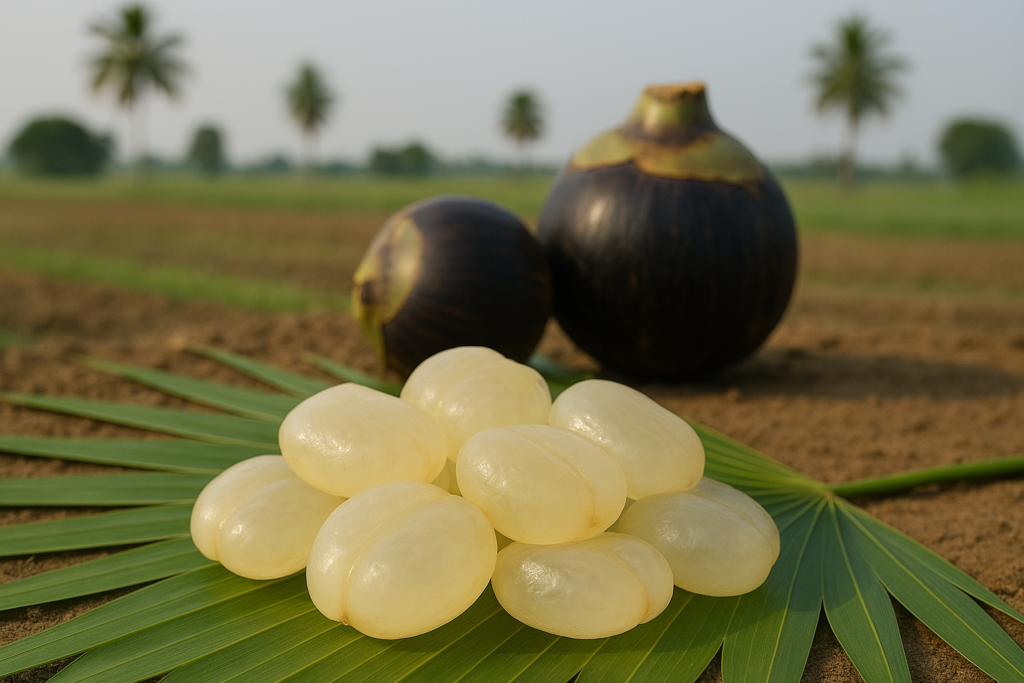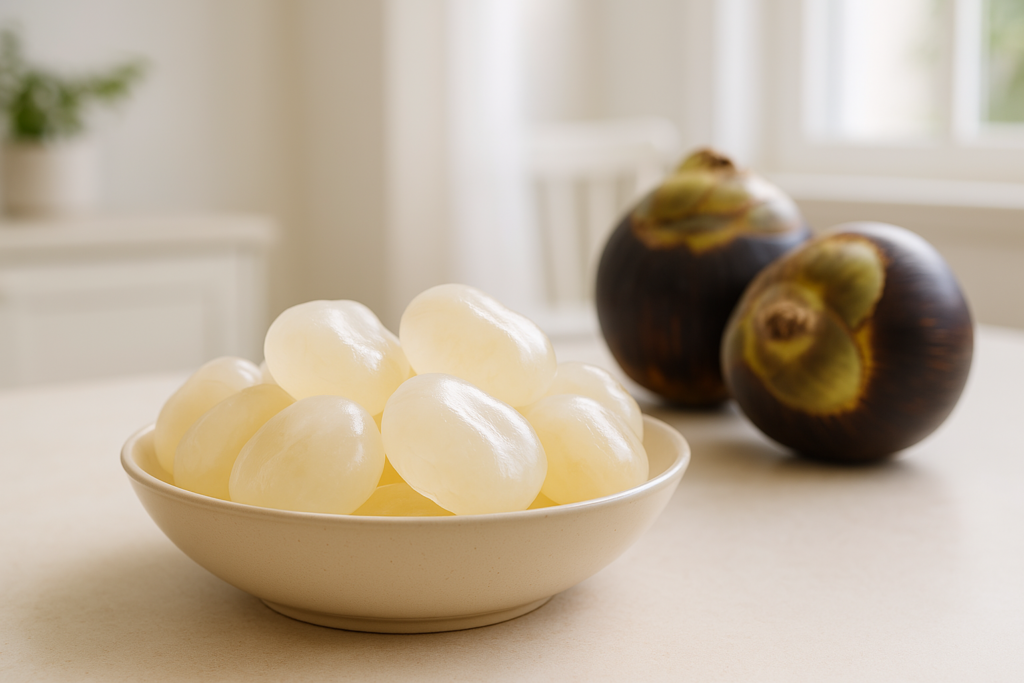Refreshing, translucent, and mildly sweet—ice apple is a summer treasure that goes by many names across India and Southeast Asia. Also known as tadgola, nungu, tale hannu, taati munjalu, and tari, this hydrating fruit is harvested from the palmyra palm (Borassus flabellifer).
Popular during hot summers, especially in coastal and southern regions of India, ice apple is prized not only for its cooling effect but also for its impressive nutritional profile.
Packed with water, fiber, and a range of bioactive compounds, it offers a natural way to beat the heat while supporting digestion, skin health, and more.
In this blog, we’ll explore the many health benefits of ice apple, blending age-old wisdom with emerging scientific insights to show why it deserves a spot in your summer diet.
Nutritional Value
According to the Indian Food Composition Tables (IFCT), a 100-gram serving of tender ice apples provides:
- Energy: 24.1 kcal
- Carbohydrate: 4.92 g
- Protein: 0.5 g
- Total Fat: 0.12 g
- Fiber: 2.40 g
- Total Sugars: 0.19 g
- Potassium: 158 mg (3% Daily Value (DV))
- Thiamine (B1): 0.01 mg (1% DV)
- Niacin (B3): 0.46 mg (3% DV)
- Pantothenic acid (B5): 0.13 mg (3% DV)
- Vitamin B6: 0.07 mg (4% DV)
- Biotin: 2.49 mcg (8% DV)
- Folate: 24.4 mcg (6% DV)
- Vitamin K: 3.60 mcg (3% DV)
- Potassium: 158 mg (3% DV)
Health Benefits
Here are the health benefits offered by ice apples.
1. Rich in Antioxidants
Ice apple isn’t just refreshing—it’s also surprisingly rich in antioxidants.
According to the Indian Food Composition Tables (IFCT 2017), it contains notable amounts of powerful polyphenols like catechin, gallocatechin, ellagic acid, chlorogenic acid, kaempferol, and quercetin.
These compounds help neutralize free radicals in the body, protecting your cells from oxidative stress and reducing the risk of inflammation-related diseases.
With about 6.84 mg of catechin alone per 100 grams, ice apple stands out as an underrated yet potent antioxidant source.
Including palmyra fruit in your diet may support better skin, immunity, and overall wellness—making this summer fruit as beneficial as it is cooling.
2. May Provide Hydration and Cooling Effect
Ice apple is a natural hydrating food, especially beneficial in hot climates.
With its high water content (nearly 92%), it helps replenish fluids lost due to heat, making it an ideal refreshment during summer. It also contains small amounts of sodium and potassium, which may help maintain electrolyte balance.
Traditionally, it has been used in Ayurveda for its cooling effect, helping balance the body’s internal heat and maintaining a healthy body temperature.
Consuming ice apple, either as a raw fruit or in drinks, not only keeps the body cool but also supports hydration, promotes skin health, and boosts energy levels during the scorching heat.
3. May Promote Digestive Health
Palmyra fruit can be highly beneficial for digestive health due to its natural cooling and hydrating properties.
It is also a good source of dietary fiber, with insoluble fiber being more predominant, which supports bowel regularity and helps prevent constipation.
Soluble fiber offers other health benefits like lowering cholesterol, managing blood sugar levels, and supporting weight loss. However, ice apple contains only 0.53 grams of soluble fiber.
Still, its fiber content and hydration benefits make it a great addition to a digestion-friendly diet.

4. May Help in Weight Management
For those looking to manage their weight, ice apple can be a great addition to their diet.
It is low in calories (only 24.1 kcal per 100 grams) and high in water content, making it a light yet filling snack that can help reduce overall calorie intake.
Additionally, the fiber content may also aid in weight management by promoting satiety and reducing hunger pangs.
However, there are limited studies directly linking ice apple to weight management.
5. May Help Regulate Blood Sugar Levels
For individuals with diabetes, ice apple can be a refreshing and beneficial addition to the diet.
It has a low glycemic index, meaning it releases sugar slowly into the bloodstream, helping to prevent sudden spikes in blood sugar levels. Its high water and fiber content may also support healthy glucose control.
Traditionally, ice apple has been used to help regulate blood sugar, especially in hot climates where it’s commonly consumed for its cooling and hydrating effects.
Interestingly, while ice apple is the fruit of the palmyra palm, other parts of the tree—such as the sap used to make palm jaggery and palm honey—also show promise. A 2022–23 study found that these palm-derived sweeteners significantly lowered blood sugar levels in diabetic rats, performing comparably to glimepiride. They also boosted insulin release, reduced oxidative stress, and improved kidney and metabolic health.
Although these benefits come from different parts of the plant, they highlight the palmyra palm’s impressive nutritional potential.
That said, scientific studies on ice apple’s specific effects on human blood sugar are still limited. As always, individuals with diabetes should consult their healthcare provider before making dietary changes and consume fruits like ice apple in moderation.
6. Anti-Inflammatory Properties
Ice apple has natural anti-inflammatory properties that can help in reducing inflammation in the body.
Rich in essential nutrients like potassium, vitamin B-complex, and antioxidants, it reduces oxidative stress and promotes cellular repair.
A cellular study suggests that the palmyra flower, from which the ice apple fruit develops, possesses strong anti-inflammatory properties.
Animal studies have also shown similar effects. One study tested the anti-inflammatory effects of ethanol extract from male palmyra flowers in rats. At doses of 150 and 300 mg/kg, it significantly reduced inflammation in both acute and chronic models, and improved related biochemical markers, supporting its traditional use.
Its cooling nature may alleviate heat-induced inflammation, making it effective for conditions like skin rashes and digestive discomfort.
Additionally, this tropical fruit may support hydration and detoxification, further reducing inflammation and promoting overall wellness.
7. May Enhance Skin Health
The palmyra fruit may offer significant dermatological benefits due to its rich bioactive compounds.
Rich in antioxidants like polyphenols, flavonoids, and carotenoids, it helps fight free radicals, protect against UV damage, and delay visible signs of aging such as wrinkles and pigmentation.
Its anti-inflammatory components—found in both the fruit and male flower extracts—soothe redness, acne, and irritation.
The fruit also offers antimicrobial benefits, helping manage acne-causing bacteria and promoting faster wound healing. The presence of natural moisturizers like pectin and hemicellulose improves skin barrier function and locks in moisture.
Palmyra’s bioactive compounds may also support healing in burns, surgical wounds, and chronic skin issues like psoriasis and vitiligo. Today, it’s not just a traditional remedy—it’s a key ingredient in face creams, under-eye gels, soaps, and even natural toothpaste, making it a holistic skincare solution.

How to Enjoy Ice Apple
Let us see how you can include Ice apple into your diet:
- Fresh: Simply peel and eat the fresh, jelly-like fruit.
- In Salads: Add it to fruit salads for a refreshing twist.
- Smoothies: Blend it into smoothies for a hydrating and nutritious drink.
- Desserts: Use it in traditional desserts or puddings for added flavor and texture.
Potential Side Effects of Ice Apple
While ice apple has a natural cooling effect and offers several health benefits, like any seasonal fruit, moderation is key. Eating too many at once may lead to mild digestive issues such as bloating or diarrhea, particularly in those with sensitive stomachs.
Although rare, some people may experience allergic reactions like itching, rashes, or a burning sensation in the mouth.
Ice apples also have a short shelf life and spoil quickly. Consuming them after fermentation or spoilage can cause nausea, vomiting, or an upset stomach. Moreover, poor hygiene during handling or selling—especially by roadside vendors—can increase the risk of contamination.
To enjoy its refreshing goodness without worry, always choose fresh, clean, and properly stored ice apples. Cutting whole fruits yourself might be a bit tricky, but it’s often a safer and more hygienic option.
Conclusion
Ice apple, with its numerous health benefits and refreshing properties, is a fantastic fruit to include in your diet, especially during the summer months.
Its high water content, essential minerals, and anti-inflammatory properties make ice apple a versatile and healthful choice. However, human research on its health benefits remains limited, and more studies are needed to confirm its effects.
Whether you enjoy it fresh, in salads, or blended into smoothies, ice apple is sure to keep you hydrated, energized, and healthy.
Incorporate ice apple into your daily diet and experience the myriad of health benefits it has to offer. Stay cool, stay healthy!
You may be also interested in
7 Amazing Dried Strawberry Benefits
9 Surprising Palm Wine Benefits
12 Super Foods for Lowering Cancer Risk


